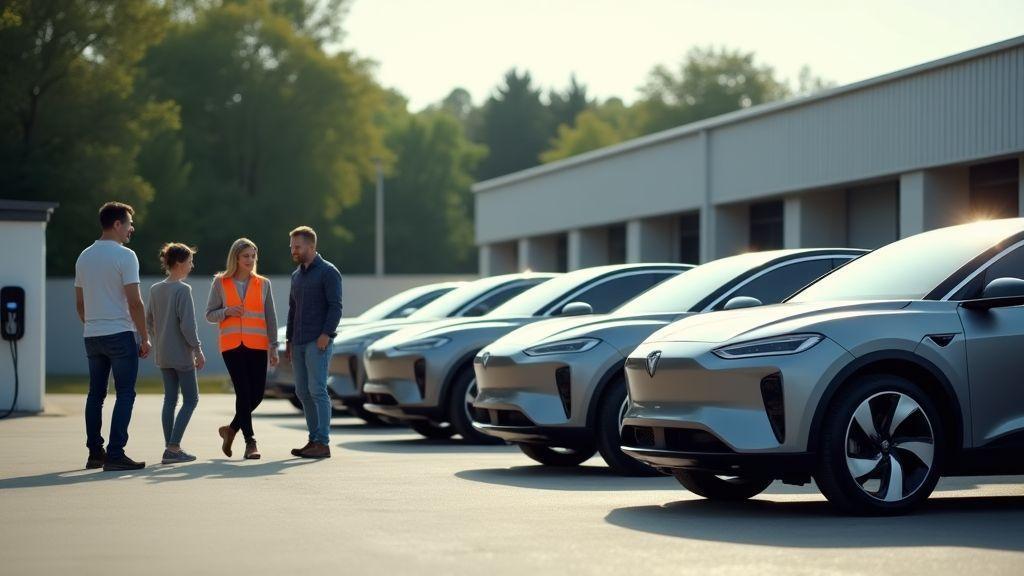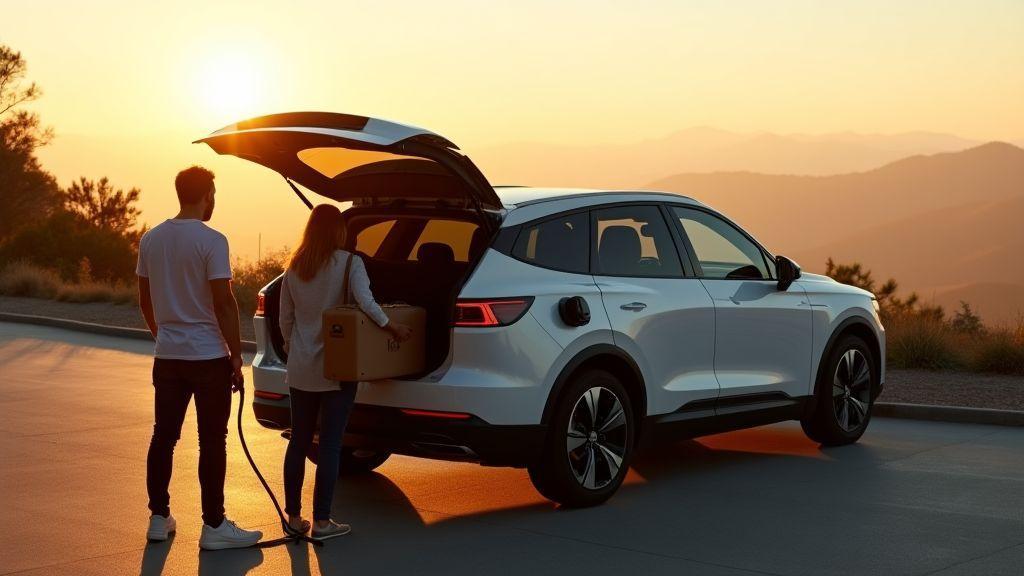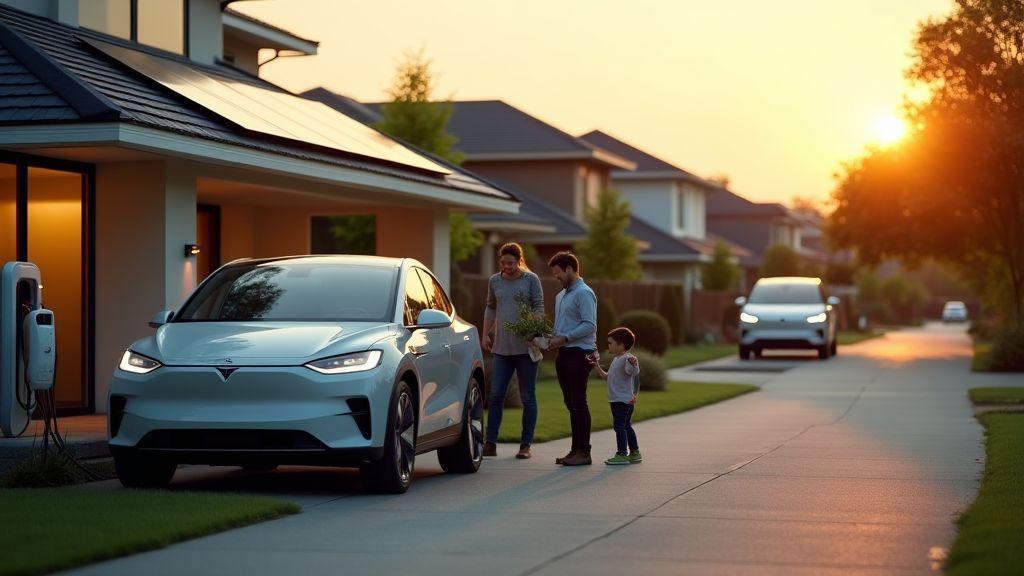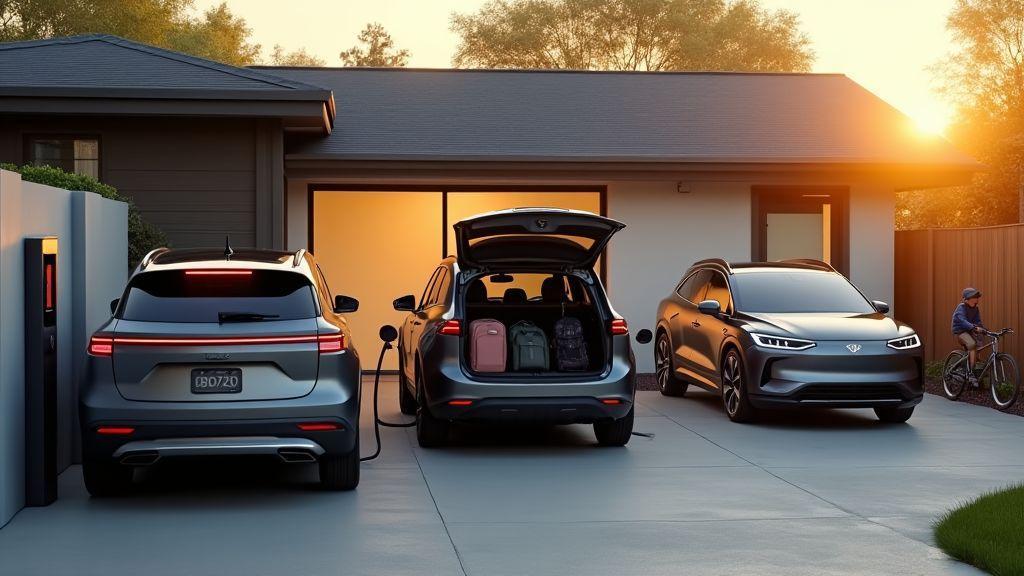Best Electric SUVs for Families in 2026
You get clear, practical guidance so you can pick the safest, roomiest, and most cost‑effective electric SUV for your family. You’ll learn to read NHTSA and IIHS crash ratings and spot the best driver assists like automatic braking. You’ll compare rear legroom, cargo space, and three‑row options so strollers and kids fit. You’ll balance EPA range with real‑world range and plan charging for family trips. You’ll factor in price, incentives, battery warranties, and total ownership cost to make a confident shortlist.
Key Takeaway
- You get longer range for family trips
- Your charging is faster and easier
- You enjoy roomy seating and advanced safety
- Your running costs are lower than gas cars
- You can pick models with lots of cargo space
(Image)
Choose the safest electric SUVs for your family in 2026 using crash ratings
You want an SUV that protects your family like a good helmet protects a cyclist. Crash ratings from government and nonprofit testers translate real crashes into simple scores you can read. Pick models with high overall scores and strong side, roof, and child‑occupant results so your kids get the best chance in a crash. For detailed independent evaluations, review IIHS crash and prevention ratings.
Crash tests measure frontal, side, rollover, and small overlap impacts. For electric SUVs, battery placement changes crash behavior—look for passenger cells that stay intact and low intrusion numbers. Also watch child‑seat compatibility and rear‑seat protection in ratings. A top‑scoring SUV that fits your car seat properly is worth more than a flashy infotainment screen. Combine crash ratings with fit tests and you’ll pick one of the Best Electric SUVs for Families in 2026 with confidence. For official test results and star breakdowns, check NHTSA crash test ratings and data.
Read NHTSA and IIHS scores so you know how your car will protect occupants
NHTSA uses a five‑star scale and checks frontal, side, and rollover risks. Aim for 4 or 5 stars overall and low rollover risk for taller SUVs. IIHS gives ratings from Good to Poor and adds headlight and crash‑avoidance checks; their Top Safety Pick labels mean the car scored well in crash tests and has strong crash‑prevention tech.
| Rating source | What it shows | What to look for |
|---|---|---|
| NHTSA Stars | Crash severity and rollover risk | 4–5 stars overall, low rollover |
| IIHS Grades | Specific crash tests and prevention tech | Good or Acceptable in key tests; Top Safety Pick badge |
Look for advanced driver assists that reduce crash risk for your kids
Active systems cut crash chances before a crash happens. Automatic Emergency Braking (AEB), lane‑keeping assist, blind‑spot monitors, and rear cross‑traffic alert are core features. These systems act like a second pair of eyes when you’re juggling car seats and snacks.
Not all systems are equal—some AEB systems brake only at certain speeds or underperform in heavy rain. Check real‑world reports and IIHS crash‑avoidance ratings. Use this quick checklist when test‑driving:
- Prioritize AEB with pedestrian and cyclist detection
- Choose lane‑keeping with clear alerts and gentle steering input
- Get blind‑spot monitors and rear cross‑traffic alerts with clear warnings
- Pick adaptive cruise control that works smoothly in stop‑and‑go traffic
- Confirm driver‑monitoring to reduce distraction‑related misses
How safety features like automatic braking affect your daily driving
Automatic braking often steps in during sudden stops or when a child darts out near a parking lot; it reduces speed fast and can prevent a hit. In daily driving you’ll notice firmer brake nudges and warnings before the car acts. Learn how the system alerts you and how to override it so it feels like a helpful co‑pilot, not an alarmist backseat driver.
Pick spacious electric SUVs so your family rides comfortably in 2026
Space is the single practical thing that will make daily drives less stressful. When you shop the Best Electric SUVs for Families in 2026, focus on rear legroom, door width, and how the cargo area swallows strollers and grocery bags. Think of the car as a small living room on wheels: if people and stuff can move around easily, life gets simpler fast.
Sit in the second row. Buckle a child seat. Fold a stroller. Open the hatch and load a week of groceries. Specs matter, but real use tells the truth. Pay attention to seat shapes, floor hump height, and how the seats tilt or slide — those little things decide if your kid can nap comfortably on a long ride.
Also think ahead—kids grow, hobbies expand, and errands pile up. A model that fits today might feel cramped in two years. Balancing passenger room, cargo space, and driving range will keep the car useful for years.
Compare rear legroom and cargo space to fit strollers and groceries in your car
Rear legroom numbers are an easy start, but how the space is used matters more. Check knee clearance, foot space, seat cushion length, cargo width, and hatch opening height. Use simple loading tests: match your folded stroller to trunk dimensions and put grocery bags on the seat to see if they sit upright.
| Vehicle size | Rear legroom (in) | Cargo volume (cu ft) | Good for |
|---|---|---|---|
| Compact EV SUV | 34–36 | 18–25 | Small family, city errands |
| Midsize EV SUV | 36–39 | 25–35 | Regular car seats, weekend gear |
| Three‑row EV SUV | 34–37 (2nd row) | 15–40 (varies with 3rd row) | Large families, carpooling |
Decide if three‑row electric SUVs for families in 2026 are right for your growing household
Three‑row SUVs give extra seats for kids, cousins, or carpool duty, but the third row often cuts cargo space and can lower driving range. If you carry passengers full time, a three‑row can be a lifesaver. If it’s used occasionally, a roomy two‑row with larger cargo might suit you better.
Think about how you actually travel: sports gear stroller three kids? Grandparents often along? If yes, the third row pulls its weight. If mostly two adults and a couple kids, a midsize two‑row usually gives a better mix of comfort and cargo.
Measure seat and trunk space before you choose a model
Do a real‑world test before you commit:
- Bring your biggest stroller and fold it.
- Measure its length and height.
- Sit in the second row with a child seat installed to check knee and foot space.
- Load groceries into the trunk and close the hatch.
Compare what fits to your daily needs.
(Image)
Find long range electric SUVs that keep your family going in 2026
You want an SUV that gets you from soccer practice to weekend escapes without constant stops. Focus on real range, cabin space, and safety features first. Long‑range batteries are great, but you also need roomy rear seats, easy car‑seat installation, and a decent cargo area for strollers and groceries.
Look beyond the headline range number. Check charging speeds, available fast chargers on your routes, and whether the car keeps range in cold weather. A model with a slightly smaller battery but better efficiency can beat a bigger battery that wastes energy hauling weight or poor aerodynamics.
Keep the phrase Best Electric SUVs for Families in 2026 in mind when you filter: prioritize practical range, family comfort, and real‑world performance.
Check EPA range and real‑world results to plan your family trips
EPA numbers are a lab‑tested maximum under set conditions—treat them as a starting point, not a promise. Speed, weather, cargo, and hills change the number fast. For many families, planning on 70–80% of EPA range gives realistic margins; leave a buffer for traffic and detours.
You can compare EPA range and efficiency estimates to plan trips.
| Typical Condition | % of EPA Range to Expect |
|---|---|
| Mild city/suburban driving | 85–100% |
| Mixed driving (city highway) | 70–85% |
| Cold weather / sustained highway / hills | 60–75% |
Balance range and efficiency so your car meets your daily and weekend needs
Bigger batteries add weight and cost. A more efficient motor, better tires, and smart heat management often give more usable miles on real roads. Match battery size to your routine: if your commute is 40 miles round trip, a 250–300 mile real‑world range is plenty. If you tow or take long road trips often, choose a larger battery and map chargers ahead. Small choices—lower roof racks, eco tires, and gentle acceleration—add up.
Plan charging stops using realistic range estimates and maps
Use a mapping app that filters by charger type and speed, add a 20–30% buffer to expected range, and pick fast chargers near amenities. Aim to charge from about 20% to 80% for fastest fills, and always check live charger status before you rely on one.
Compare affordable family electric SUVs and total ownership costs in 2026
Treat the purchase like a small business decision for your household. Look past the sticker to total cash outlay, fuel savings, and projected resale. The Best Electric SUVs for Families in 2026 are not always the cheapest up front; some models save a bundle over five years.
Add dealer discounts, federal and state incentives, home charger rebates, and lower energy costs. Subtract expected depreciation and any battery replacement risk. That gives a clearer monthly and yearly picture.
Think of ownership like packing for a long trip: range and charging must fit your routine, seating must fit kids and gear, and running costs must match your budget. If one model meets needs and saves money each year, that’s your winner.
Include purchase price, incentives, and fuel savings when you budget
Start with the out‑the‑door price you can actually pay. Ask dealers about incentives and factory discounts. Then add federal tax credits, state rebates, and local utility offers for home chargers—those numbers can move a model from out of reach to affordable. For official guidance on the federal credit and eligibility, understand federal EV tax credit details.
Add fuel savings: electricity usually costs far less per mile than gasoline. Example: if an EV uses ~3 miles/kWh and electricity costs $0.15/kWh, cost ≈ $0.05/mile. A gas SUV at 25 mpg with $4/gal ≈ $0.16/mile. Over 12,000 miles, that’s roughly $1,300 saved per year in this example. Use your local prices and miles for real figures.
Factor battery warranties and maintenance to protect your long term costs
Battery warranty length and coverage matter. Many EVs offer ~8 years or 100,000 miles of battery coverage—check what’s covered: capacity loss, full replacement, and transferability. These details affect resale and long‑term risk.
Maintenance is usually cheaper than gas SUVs, but not zero. You still pay for tires, brakes, filters, and climate system care. Ask dealers about software update policies and local service availability. A good service network keeps surprise bills down.
If you need specific legal details about incentives or warranty fine print, review the manufacturer and dealer terms of use before signing.
Calculate total cost of ownership to see which model fits your budget
- List purchase price minus incentives and add expected finance costs.
- Add yearly costs: insurance, registration, charging (use your rates), and routine maintenance.
- Estimate depreciation over your planned ownership period (commonly five years).
- Add potential battery repair or replacement costs after warranty.
- Subtract resale value.
The result is your total cost of ownership; divide by years or months to get a budget figure.
(Image)
Evaluate charging, home setup, and public chargers for family‑friendly electric crossover SUVs 2026
You want an electric crossover that fits school runs, soccer practice, and weekend getaways. Start by checking real‑world range and how you’ll charge at home and on the road. A model that lists 300 miles can feel very different if you live where winters are cold or you often use the heater for kids’ comfort.
If drives are short and predictable, overnight charging will do. If you have longer routes or two cars, plan for faster home charging or regular public chargers near routine stops. That planning saves time and stress and keeps the car ready for busy mornings.
Compare vehicles on total ownership: charging costs, charger availability, and added time for stops. That’s how you judge the Best Electric SUVs for Families in 2026—not just by seats or safety scores, but by how charging fits into your life.
Install the right home charger so your car is ready every morning for your family
A Level 2 home charger is the sweet spot for families—about 20–40 miles of range per hour, so an overnight top‑up covers most daily needs. Hire a licensed electrician to check your panel, run conduit, and mount the unit. Place the charger where your car parks nightly and set a schedule to charge during off‑peak rates. If you have two EVs, consider a charger with split‑power or a second circuit.
- Get a home energy check by an electrician.
- Choose a 240V Level 2 charger with app control.
- Place the unit where the car parks overnight.
- Set charging to off‑peak hours and test weekly.
The Department of Energy provides practical resources to find home and public charging guidance.
When you link a charging app to your home network or phone, review the service privacy policy to understand data sharing and location tracking.
Use fast charger networks and apps to plan long trips with your kids
Long drives with kids mean frequent stops—use that to your advantage. Map DC fast chargers along your route with apps like PlugShare, A Better Routeplanner, or your automaker’s app. Check charger speed and sharing—some locations slow during peak use. Pick chargers near parks, restrooms, or diners so kids can move while the car charges.
Estimate daily charging time and costs based on your driving patterns
Calculate miles per day ÷ efficiency (miles/kWh) = kWh/day. Multiply by local electricity rates for daily cost. Estimate time by charger power:
| Charger Type | Typical Power | Miles Added per Hour | Typical Use |
|---|---|---|---|
| Level 1 (120V) | 1–1.5 kW | 3–5 miles/hr | Overnight top‑ups, very light use |
| Level 2 (240V) | 6–11 kW | 20–40 miles/hr | Home daily charging |
| DC Fast | 50–350 kW | 150 miles in 20–30 min (varies) | Road trips, quick top‑ups |
Narrow choices with top‑rated family electric SUVs 2026 to find the Best Electric SUVs for Families in 2026
Start by shrinking the field. List five to seven SUVs that fit your basics: seating for kids and car seats, enough cargo for strollers and sports gear, and a realistic driving range for your daily trips. Pick models with good warranties and dealer support where you live.
Match those cars to how your family lives. If you haul a lot, prioritize cargo layout and flat load floors. If you do long highway trips, give range and charger speed more weight. If you mostly school‑run, comfortable rear seats and easy child‑seat access should move up the list.
Do short test drives in town and on the highway. Open and close rear doors, fold seats, try a mock stroller fit. These simple moves tell you more than specs. With hands‑on work, your shortlist will feel right, not just right on paper.
Read expert reviews and owner feedback so you know what to expect from your vehicle
Read recent expert reviews for measured takes on performance, safety, and comfort. Experts test braking, crash‑avoidance systems, and real‑world range, and compare cabin noise and ride comfort. Then check owner feedback for long‑term issues and small annoyances—software updates, service waits, or seat wear. Combine expert tests with owner stories so you won’t be surprised after purchase.
If you want personalized help narrowing choices, reach out through our contact page to ask questions about local dealers and service networks.
Compare safety, space, range, and price to pick the best family EV SUVs 2026 for your needs
Put safety at the top. Look for high crash‑test scores, stable handling, and solid driver‑assist features. Also check for easy‑to‑use LATCH anchors and clear rear visibility. Balance space, range, and price against real use: cargo cubic feet and rear‑seat legroom matter more than headline horsepower.
| What to compare | What to look for | One quick question to ask |
|---|---|---|
| Safety | Crash‑test ratings, driver aids, child‑seat anchors | Will this protect kids in common crash types? |
| Space | Rear legroom, cargo layout, seat folding ease | Can my stroller or gear fit without folding seats? |
| Range & Charging | Real‑world range, fast‑charge rate, network access | Can I cover my usual trips and recharge quickly? |
| Price & Running Costs | MSRP, incentives, charging costs, warranty | What will I pay over five years, not just at purchase? |
Use ratings and test data to make your final shortlist before you buy
Turn scores and test numbers into a shortlist of two or three cars and compare them side by side. Use crash‑test pages, range test results, and reliability ratings to rank your picks. If one model beats the others on the few items you care about, take the next step: a long test drive and a check of local service options.
Conclusion
You now know how to choose the Best Electric SUVs for Families in 2026: prioritize safety, space, real‑world range, charging convenience, and total ownership cost. Think of the decision like packing for a long trip—pick what actually fits, not just what looks good on paper.
Do the simple tests. Read NHTSA and IIHS scores. Verify LATCH fit and rear legroom. Fold your stroller into the trunk. Map real chargers and consider a Level 2 home charger. Shortlist two or three models, then take them on both town and highway drives. Let practical trade‑offs — not glossy specs — steer your choice.
Make your final pick where comfort, safety, and everyday convenience meet. When your kids, gear, and routine all fit, you’ll have the right family EV, not just the flashiest one. For more detailed guides and model picks, visit the Meridian Pioneer home page.

